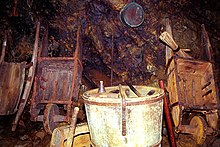Wheelbarrow
The wheelbarrow , also known as wheelbarrows, is a special form of wheelbarrow that was used in mining for haulage . In ore mining , the cart was called the cross cart because the miner who pushed the cart put the straps around his " cross ".
Basics
In the early days of the Ruhr mining industry, coal was transported by wheelbarrow from the colliery to the coal mine . Depending on the nature of the subsurface, walking boards were laid out, the so-called "sliding path". In contrast to the wheelbarrow, the cart was not lifted and pushed with the hands, but by means of a wide strap that was placed over the shoulders. The hands were only used to balance the cart and make steering corrections. The worker who had to push the cart was called the cart runner . Later, the wheelbarrow was replaced by the hunt as a delivery vessel . In Saxony , wheelbarrow is the regional expression for wheelbarrow.
construction
The trolley consists of a box with straight or inclined side boards. The so-called cart legs or cart trees are attached to the box on both side walls. The legs are either made from strong stakes and bolted to the side boards or made in one piece with the side boards. With the former variant, any damaged cart legs can be replaced more easily. A wheel made of cast steel or wrought iron is attached to the front side. There are also carts in which the wheel is made of wood reinforced with an iron tire. The diameter of the wheel is different in the respective mining areas , it is between 41 and 55 centimeters. In the mechanical sense, the trolley forms a one-armed lever; the wheel forms the moving base. In the lignite mines of Eggersdorf , carts made of sheet iron were used. In Saxony there were so-called trolleys with removable vessels.
Volume
The volume of the carts varied and was dependent on the specific weight of the goods being conveyed . Often the basic box was built small and could be enlarged with attachment boards. In the Saxon mines carts with a volume of around 90 liters were used for ore extraction; the weight of the load was up to two hundredweight. In the silver, cobalt and lead mines in Freiberg , the carts had a capacity of around 27 liters. In coal mines, the carts had a volume of between 70 and 145 liters. One to two quintals of lignite were transported with it. In the hard coal mines in Saarland, between 2.5 and 3 quintals of hard coal were transported with the carts.
Individual evidence
- ↑ Barrow at Zeno.org (last accessed on April 9, 2015)
- ^ Gustav Köhler: Textbook of mining science. 6th edition. Published by Wilhelm Engelmann, Leipzig 1903.
- ↑ Albert Serlo: Guide to mining science. Second volume, 3rd edition. Published by Julius Springer, Berlin 1878.


